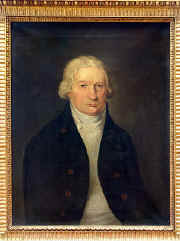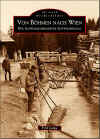MONTHLY HIGHHOLDER
November 2004
Vol. 3 Issue 11
I am going to order this book if anyone wants to get a copy for themselves let me know and I will order them all at the same time to save on shipping. Send me an email by November 15th. The book is about $25 plus shipping.
Von Böhmen nach Wien
Der Schwarzenbergische
Schwemmkanal
Hello Mr. Kindermann,
I have mentioned some months ago the work on my second book about the timber canal from the Bohemian Woods, the famous "Schwarzenbergische Schwemmkanal". I think Fred Schröder has translated the press-note for you and as he is more experienced in english I think I don't need to translate it again. Please feel free to use some text from it. Now that the book will be available from next week on I will give you and your readers some additional information and also some historic pictures:
The story of the Schwemmkanal fascinates me more and more, the longer I worked on it. It was clear for me, that the target "a historic picture album" would be very difficult, because the few people living on the Czech side of the border do not know much about the canal and of course they do not have old pictures! The former German speaking people, who have lost nearly everything in 1945/46 are spread all over Europe - and also USA! But I was very successful!
Above all I want to mention the people, who once lived and worked along the canal and gave me the most important informations:
- Charlotte von Rosenauer, widow of Felix III Rosenauer, great-great-grandson of Joseph Rosenauer, now living in Austria,
- Prof. Fritz and Franz Bertlwieser from Reiterschlag, now living in Austria,
- Horst Wondraschek from Krumau, who restored church and churchyard in Glöckelberg (his mother comes from Glöckelberg), now living in Austria,
- Walter Franz from Josefstal, coming from a glass worker family, now living in Austria,
- Dr. Otto Spitzenberger from Oberplan with one of the biggest collections of Böhmerwald-postcards, now living in Austria,
- Helmut Mitgutsch from Klaffer/Austria, collector of old Böhmerwald-photos,
- and last but not least Fred and Othmar Schröder from Hirschbergen! Fred now lives in USA, Othmar in Germany.
A 1190 Wien
f.lange@utanet.at
Ein
historischer Bildband über den ehemaligen Holztransportweg
A historic picture series,-
publication over the former wood transportation system
Auf
128 reich illustrierten Seiten führt der Autor den Leser auf einen Streifzug
durch die Geschichte des Schwarzenbergischen Schwemmkanals im Grenzgebiet
zwischen Österreich, Böhmen und Deutschland. Über 200 Fotografien und
Grafiken zeigen das historisch bedeutsame Bauwerk und das Leben und Arbeiten am
Kanal, mit dessen Hilfe Brennholz aus den böhmischen Wäldern über die europäische
Haupt-Wasserscheide nach Wien gebracht wurde. Aus privaten Fotosammlungen, Erzählungen
von ehemaligen Bewohnern des Böhmerwalds, Holzhauern und Schwemmarbeitern
sowie zahlreichen Plänen und Abbildungen aus Archiven und Heimatmuseen hat
Fritz Lange die interessantesten Objekte gewählt und zu einem öffentlichen
Fotoalbum zusammengestellt. Dieser Bildband lädt ein zum Erkunden, zum Neu- und
Wiederentdecken des ehemaligen Wasserweges.
On 128 very
explained illustrated pages, the Autor guides the reader through a series of
history of the Schwarzenberg (wood)floating channel in the border area between
Austria, Bohemia and Germany. Over 200 photos and illustrations are showing this
historic important building project, and the life and work on the channel; with
their help was fire wood from the bohemian forest delivered over the main
European water dividing line to to Viena.
From
privat photo collections,interviews from former residents of the Bohemian
Forest, wood cutters an channel workers, as of blue prints and copies from
Archives and Homeland Museums, Fritz Lange selected the interesting objects, and
made a public photo album. This picture serie invites you to inquire to a new
disvovery of the former waterway.
Das einleitende Kapitel erzählt die spannende Geschichte von Joseph
Rosenauer, genialer Planer, Erbauer und erster Schwemmdirektor des
Schwarzenbergischen Schwemmkanals.
·
In
weiteren Kapiteln folgt der Bildband bei sechs Spaziergängen dem Verlauf
des Kanals von der Großen Mühl bis zum Lichtwasserbach in Böhmen.
Verschwundene Ortschaften wie Asang, Glöckelberg, Josefstal und Hüttenhof
werden genauso zum Leben erweckt wie die Arbeit und das Leben in den
Schwarzenbergischen Wäldern und am Kanal.
·
Die Bilder in
diesem Buch spiegeln die Entwicklung des Holztransportweges vom ersten Projekt
1776 über Bau und Nutzung bis in die jüngste Zeit wieder, in der der alte
Wasserweg, freigelegt und restauriert, zu einem der schönsten Wander- und
Radwege Mitteleuropas wurde.
Der
Autor Dipl.-Ing. Fritz Lange beschäftigt
sich seit Jahrzehnten mit den technischen und historischen Details des Kanalbaus
und hat für dieses Buch Bilddokumente aus einer Zeitspanne von
240 Jahren ausgewählt. Im Sutton Verlag ist 2003 sein erstes Buch „Von
Wien zur Adria. Der Wiener Neustädter Kanal“ erschienen, das jetzt schon
seine 3. Auflage erreicht hat.
In
further sections follows a picture series of six walking trips of the course of
the channel from the big river Mühl
Till to the
Lichtwasser creek in Bohemia. Disappeared Villages like Asang, Glöckelberg,
Josefstal and Hüttenhof are awaken a life again,
and as the work and life in the Schwarzenberg forests and on the channel.
The pictures in this
book are reflecting the progress of the wood transport road from the first
project in 1776,
during the building
and operating until the present time, in which the old water way was cleared an
restored
to the beautiful lest
walking an bicycle routes in middle Europe.
The Author Dipl.- Ing.
Fritz Lange, researches already decates with technical and historic details for
the channel
Building, and
selected for this book pickture documents from a time period of 240 years
The Sutton Publishers
issued his first book in 2003,-„From Viena to the Adria“.
Von Böhmen nach Wien
Der Schwarzenbergische
Schwemmkanal
von Fritz Lange
erscheint
im November 2004, Due in November
beim
Sutton Verlag
ISBN
3-89702-723-2
18,90
EUR [A]
128 S.,
ca. 200 Abb.
Die
Reihe Archivbilder ist
im gut sortierten Buchhandel erhältlich.
Der
Sutton Verlag wurde vom britischen Verleger Alan Sutton gegründet und hat sich
zum Ziel gesetzt, die Alltagsgeschichte von Städten und Gemeinden in
historischen Bildbänden einzufangen. Bisher hat der Sutton Verlag in seiner
Reihe „Archivbilder“ in
Deutschland und Österreich über 500 Bildbände herausgegeben.
THE
Sutton Publishers Co. Were established from a British Edtidor Alan Sutton, he made
his target to catch all days stories from cities and municipalities
In
historic picture books. Since, the Sutton Publishers issued a series of „Archive Pictures“
in Germany and Austria, and issued over 500 picture volumes.
Pressestimmen
über verschiedene Bände der Reihe Archivbilder:
Press comments over different volumes, series Archive
pictures
„...eine Vielzahl von
Schnappschüssen, für die nachfolgende Generationen dankbar sind.“ Die
Presse
many snapshots, the future generation will be thankfull
for it. THE PRESS
„Für eine Schmökertour durch die Geschichte des
Heimatbezirkes sind diese üppig illustrierten und für jedermann
erschwinglichen Bände sehr zu empfehlen.“ Wiener
Zeitung
For a Schmöker tour trough history of the home
district, are these luxurious illustrations afordable and very recommended
for everyone. VIENA NEWSPAPER
„Ein Spaziergang als
Zeitreise ...“ Neue Kronenzeitung
„A walk as a history trip“ New Kronen Newspaper.
„.. lässt Geschichte
wieder aufleben.“ ORF.on
„let History come a life again, “ ORF
„Die kurzen, schnörkellosen
Texte beschönigen nichts und verleihen den Privataufnahmen eine ganz besondere
Authentizität.“ APA
„the short script less texts don’t hide nothing and
give the privat made pictures a special authentic ,“ APA
„Nicht nur eine Sache für
Nostalgiker, eine Entdeckungsreise für jeden.“ Oberösterreichische Nachrichten
„Not only a matter for Nostalic, a exploration trip
for every one, “ Upper Austrian Nachrichten.
„Es ist ein Buch vom
Menschen.“ NÖN
„It
is a book from people “ NÖN
Weitere
Informationen und Rezensionsexemplare erhalten Sie bei:
Further
Informations and Recensions Exemplars available by:
Mag. Katharina Schmidt-Chiari
Sutton Verlag –
Verlagsbüro Österreich
Lenaugasse 9/24, 1080 Wien
Tel/Fax: +43-1-40 66 110
austria@suttonverlag.de
www.suttonverlag.de
Dear Peter
I have also heard the story that Ken Mauritz related. Father Bastian was
for a long
time
the Pastor of St. Vincent's, and it was because of him that the Church which
stands
now, was built. The earlier Church burned down in 1910- (date unknown)
The
new church was rebuilt in 1917.
Father
Bastian was from that region of Germany that had just been re-annexed
to
Germany, the Alsatian, or Alsace Lorraine region, during the 1868 war, between
France
and Germany.
I know that he always held Mass in German, so he was a fluent speaker of the
German
language.
For many years his relatives continued to go to St. Vincent Church, and I
believe
they
lived on South Park Avenue towards the Lake. I don't know if they are still in
Oshkosh,
anymore.
The reason that so many people walked out, was because many of the Parishioners
had
family fighting in the German Army. My grandfather had 4 brothers fighting
for
Germany, and one of them was killed near the Battle of the Somme.
This
event probably occurred in 1914, and at that time, the sentiment in Oshkosh was
for
the
German Army, but later in 1917, when the U.S. joined the war, and many people of
Oshkosh
had to register for the Draft, that sentiment changed overnight. I have seen
records
that my grandfather Alois Nigl registered for the draft in 1917, but since he
had
13 children, he was never called.
Charles Nigl
Interesting Links
International conference on groundwater in fractured rocks.
2003 in Czech Republic
Some good pictures of Bohemia while the site lasts
International Friends of Nature
Landscape of the Year 1999/2000 - Bohemian Forest/Šumava
The Bohemian Forest
A tale of two National Parks
Bohemian Forest - day #5 photo album
a paper
presented at the Bukovinafest, September 19, 2003, Ellis, Kansas
by Rebecca Hageman, Wichita, KS
Be sure to visit the site map page to see all that is available
A really good web site about Bukovinians







